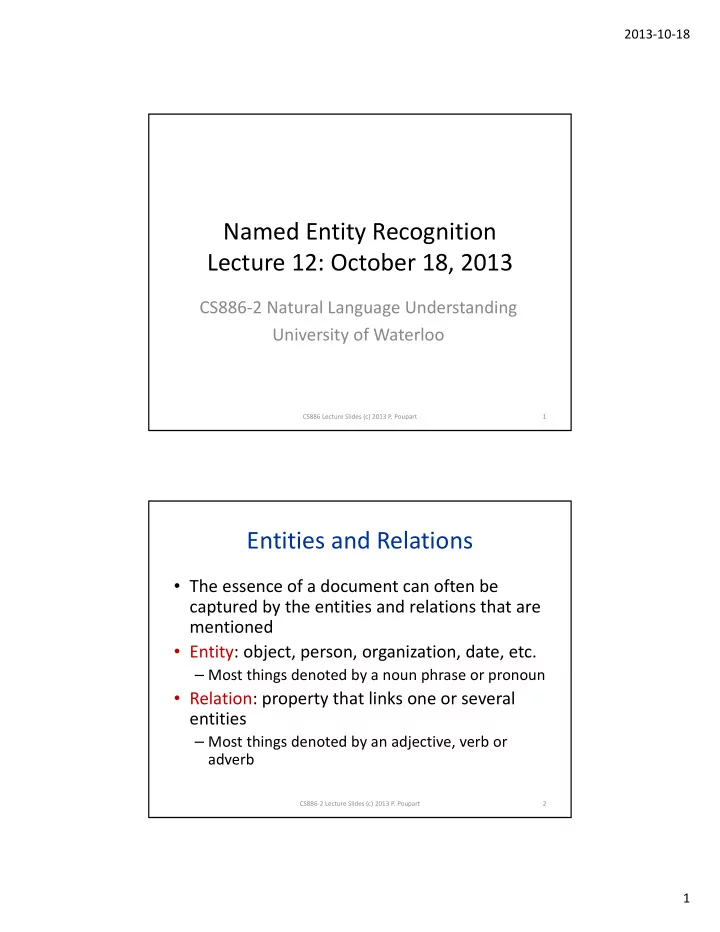

2013 ‐ 10 ‐ 18 Named Entity Recognition Lecture 12: October 18, 2013 CS886 ‐ 2 Natural Language Understanding University of Waterloo CS886 Lecture Slides (c) 2013 P. Poupart 1 Entities and Relations • The essence of a document can often be captured by the entities and relations that are mentioned • Entity: object, person, organization, date, etc. – Most things denoted by a noun phrase or pronoun • Relation: property that links one or several entities – Most things denoted by an adjective, verb or adverb CS886 ‐ 2 Lecture Slides (c) 2013 P. Poupart 2 1
2013 ‐ 10 ‐ 18 Named Entities • Among all entities, named entities are often the most important ones for – Text summarization – Question answering – Information retrieval – Sentiment analysis • Definition: subset of entities referred by a “rigid designator” • Rigid designator: expression that always refers to the same thing in all possible worlds CS886 ‐ 2 Lecture Slides (c) 2013 P. Poupart 3 Named Entity Recognition (NER) • Task: – Identify named entities – Classify named entities • Classes: – Common: Person, organization, location, quantity, time, money, percentage, etc. – Biology: genes, proteins, molecules, etc. – Fine grained: all Wikipedia concepts (one concept per Wikipedia page) CS886 Lecture Slides (c) 2013 P. Poupart 4 2
2013 ‐ 10 ‐ 18 News NER example CS886 Lecture Slides (c) 2013 P. Poupart 5 Biomedical NER example CS886 Lecture Slides (c) 2013 P. Poupart 6 3
2013 ‐ 10 ‐ 18 Classification • Approach: classify each word (phrase) with an entity type • Supervised learning: – Train with corpus of labeled text (labels are entity types) • Semi ‐ supervised learning: – Train with some labeled texts and large corpus of unlabeled texts CS886 Lecture Slides (c) 2013 P. Poupart 7 Independent Classifiers • Classify each word in isolation – Naïve Bayes model – Logistic regression – Decision tree – Support vector machine CS886 Lecture Slides (c) 2013 P. Poupart 8 4
2013 ‐ 10 ‐ 18 Correlated Classifiers • Jointly classify all words while taking into account correlations between some labels – Hidden Markov Model – Conditional Random Field • Adjacent words (phrases) often have correlated labels • Identical words often have the same label CS886 Lecture Slides (c) 2013 P. Poupart 9 Naïve Bayes Model • Picture CS886 Lecture Slides (c) 2013 P. Poupart 10 5
2013 ‐ 10 ‐ 18 Features • Features are more important than the model itself – Results: very sensitive to the choice of features • Feature: anything that can be computed by a program based on the text • Common features: – Word, previous word, next word (more words do not seem to help) – Prefixes and suffixes – Shape – Combination of features – Part ‐ of ‐ speech tags – Gazetteer CS886 Lecture Slides (c) 2013 P. Poupart 11 Common Features • Word, previous word, next word • Prefixes and suffixes • Shape CS886 Lecture Slides (c) 2013 P. Poupart 12 6
2013 ‐ 10 ‐ 18 Common Features • Part ‐ of ‐ speech tags • Gazetteer • Combination of features CS886 Lecture Slides (c) 2013 P. Poupart 13 Training • Generative training: maximum likelihood – � ∗ � ������ Pr �����, �������� � – Closed form solution: relative frequency counts – Fast, but inaccurate • Discriminative training: conditional maximum likelihood – � ∗ � ������ Pr ����� ��������, � – No closed form solution: iterative technique such as gradient ascent – Slow but more accurate (optimize the right objective) CS886 Lecture Slides (c) 2013 P. Poupart 14 7
2013 ‐ 10 ‐ 18 Example CS886 Lecture Slides (c) 2013 P. Poupart 15 Derivation CS886 Lecture Slides (c) 2013 P. Poupart 16 8
2013 ‐ 10 ‐ 18 Logistic Regression • Alternative to Naïve Bayes model – Different parameterization, but often equivalent to discriminative naïve Bayes learning • Idea: joint distribution is proportional to the exponential of a weighted sum of the features Pr ����� � ��������, � ∝ � ∑ � �� � � ����� � CS886 Lecture Slides (c) 2013 P. Poupart 17 Example CS886 Lecture Slides (c) 2013 P. Poupart 18 9
2013 ‐ 10 ‐ 18 Discriminative Training • Maximize conditional likelihood � ∗ � ������ � Pr ������|��������, �� • No closed form solution: iterative technique – E.g. Gradient ascent CS886 Lecture Slides (c) 2013 P. Poupart 19 Joint Classification • Joint classification allows us to take into account correlations between some labels – Adjacent words often have correlated entity types – Identical words often have the same entity type • Approaches: – Naïve Bayes extension: Hidden Markov Model – Logistic regression extension: conditional random field CS886 Lecture Slides (c) 2013 P. Poupart 20 10
Recommend
More recommend